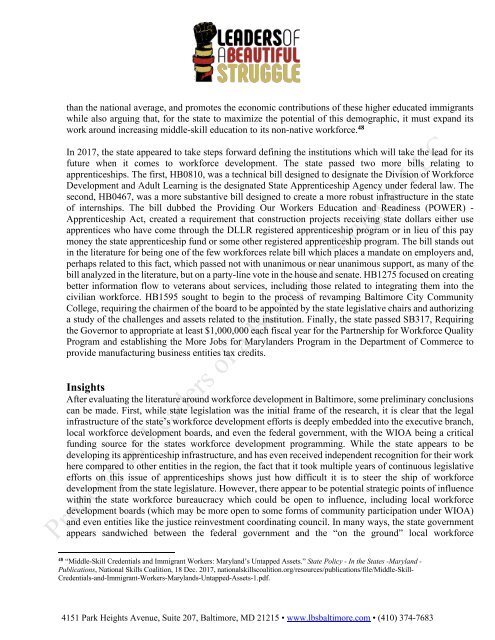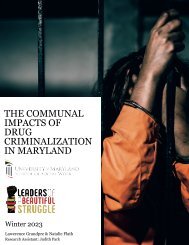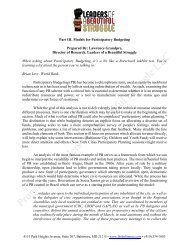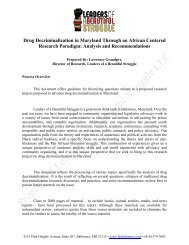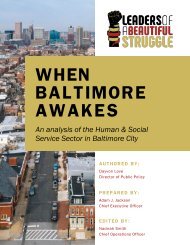Workforce Development Legislation and Practice Literature Review, Maryland, 2007-2017
This document attempts to create an overview of the literature around the legislative and political dynamics around workforce development theory and practice in Maryland through the years 2007 through 2017. This period includes three different gubernatorial regimes, three presidents, a massive shift in federal workforce development policy, and the largest economic contraction in the United States since the great recession. While the tumultuous circumstances this time period encompasses adds an additional layer of complexity to an already diverse state workforce environment, over time general trends can be observed and evaluated
This document attempts to create an overview of the literature around the legislative and political dynamics around workforce development theory and practice in Maryland through the years 2007 through 2017. This period includes three different gubernatorial regimes, three presidents, a massive shift in federal workforce development policy, and the largest economic contraction in the United States since the great recession. While the tumultuous circumstances this time period encompasses adds an additional layer of complexity to an already diverse state workforce environment, over time general trends can be observed and evaluated
Create successful ePaper yourself
Turn your PDF publications into a flip-book with our unique Google optimized e-Paper software.
than the national average, <strong>and</strong> promotes the economic contributions of these higher educated immigrants<br />
while also arguing that, for the state to maximize the potential of this demographic, it must exp<strong>and</strong> its<br />
work around increasing middle-skill education to its non-native workforce. 48<br />
In <strong>2017</strong>, the state appeared to take steps forward defining the institutions which will take the lead for its<br />
future when it comes to workforce development. The state passed two more bills relating to<br />
apprenticeships. The first, HB0810, was a technical bill designed to designate the Division of <strong>Workforce</strong><br />
<strong>Development</strong> <strong>and</strong> Adult Learning is the designated State Apprenticeship Agency under federal law. The<br />
second, HB0467, was a more substantive bill designed to create a more robust infrastructure in the state<br />
of internships. The bill dubbed the Providing Our Workers Education <strong>and</strong> Readiness (POWER) -<br />
Apprenticeship Act, created a requirement that construction projects receiving state dollars either use<br />
apprentices who have come through the DLLR registered apprenticeship program or in lieu of this pay<br />
money the state apprenticeship fund or some other registered apprenticeship program. The bill st<strong>and</strong>s out<br />
in the literature for being one of the few workforces relate bill which places a m<strong>and</strong>ate on employers <strong>and</strong>,<br />
perhaps related to this fact, which passed not with unanimous or near unanimous support, as many of the<br />
bill analyzed in the literature, but on a party-line vote in the house <strong>and</strong> senate. HB1275 focused on creating<br />
better information flow to veterans about services, including those related to integrating them into the<br />
civilian workforce. HB1595 sought to begin to the process of revamping Baltimore City Community<br />
College, requiring the chairmen of the board to be appointed by the state legislative chairs <strong>and</strong> authorizing<br />
a study of the challenges <strong>and</strong> assets related to the institution. Finally, the state passed SB317, Requiring<br />
the Governor to appropriate at least $1,000,000 each fiscal year for the Partnership for <strong>Workforce</strong> Quality<br />
Program <strong>and</strong> establishing the More Jobs for Maryl<strong>and</strong>ers Program in the Department of Commerce to<br />
provide manufacturing business entities tax credits.<br />
Insights<br />
After evaluating the literature around workforce development in Baltimore, some preliminary conclusions<br />
can be made. First, while state legislation was the initial frame of the research, it is clear that the legal<br />
infrastructure of the state’s workforce development efforts is deeply embedded into the executive branch,<br />
local workforce development boards, <strong>and</strong> even the federal government, with the WIOA being a critical<br />
funding source for the states workforce development programming. While the state appears to be<br />
developing its apprenticeship infrastructure, <strong>and</strong> has even received independent recognition for their work<br />
here compared to other entities in the region, the fact that it took multiple years of continuous legislative<br />
efforts on this issue of apprenticeships shows just how difficult it is to steer the ship of workforce<br />
development from the state legislature. However, there appear to be potential strategic points of influence<br />
within the state workforce bureaucracy which could be open to influence, including local workforce<br />
development boards (which may be more open to some forms of community participation under WIOA)<br />
<strong>and</strong> even entities like the justice reinvestment coordinating council. In many ways, the state government<br />
appears s<strong>and</strong>wiched between the federal government <strong>and</strong> the “on the ground” local workforce<br />
48<br />
“Middle-Skill Credentials <strong>and</strong> Immigrant Workers: Maryl<strong>and</strong>’s Untapped Assets.” State Policy - In the States -Maryl<strong>and</strong> -<br />
Publications, National Skills Coalition, 18 Dec. <strong>2017</strong>, nationalskillscoalition.org/resources/publications/file/Middle-Skill-<br />
Credentials-<strong>and</strong>-Immigrant-Workers-Maryl<strong>and</strong>s-Untapped-Assets-1.pdf.<br />
4151 Park Heights Avenue, Suite 207, Baltimore, MD 21215 • www.lbsbaltimore.com • (410) 374-7683


